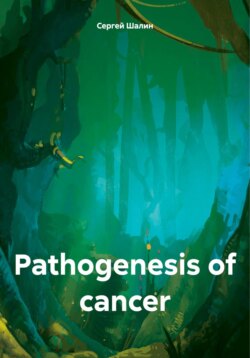Читать книгу Pathogenesis of cancer - - Страница 4
ONCOGENESIS
ОглавлениеThe basis for the growth and development of oncogenesis is a malignant stem cell, and the basis for the “generation” of a malignant stem cell is the return of a tissue Monocyte, which has genotypic and epigenetic changes, to the embryonic state during mitosis, a differentiation block at the pluripotent or unipotent level and transformation. Monocyte – with a diameter of 16–18 microns, various morphological variations in the nature and intensity of coloring of the nucleus and cytoplasm. The kernels may approach round, bean-shaped shapes. The cytoplasm is grayish or pale blue in color and may contain numerous dust-like azurophilic granules. Differentiation of Monoblast into Monocyte occurs in the red bone marrow within 5 days. A monocyte stays in the bone marrow for an average of 3 days, then divides and, without forming a bone marrow reserve, enters the peripheral blood. In the blood, the Monocyte is the largest blood cell, here it matures, the nucleus becomes from round, first bean-shaped, then clawed, and the chromatin structure changes. Various levels of monocyte differentiation were found in peripheral blood, with more mature monocytes predominating in healthy people. In the blood, monocytes are distributed into parietal and circulating pools, exchanging with each other, the quantitative ratios of which may vary. In humans, the circulating pool of Monocytes is normally 18x10 to the 6th degree cells/kg body weight, and the marginal pool, which currently does not take part in the circulation, adjacent to the inner wall of the microvessel, is 3.5 times larger (63x10 to the 6th degree of cells/ kg body weight). In general, the total pool of peripheral blood monocytes constitutes from 1 to 10% of all leukocytes (80–600 x 109/l). Monocytes circulate in the blood from 36 to 104 hours (1.5 – 4.5 days) and then leave it according to a stochastic principle, interacting with specialized adhesion molecules on endothelial cells. Monocyte migration from the vascular bed to the focus of chronic inflammation occurs through areas of the microcirculatory bed with the second type of endothelium – these are postcapillaries and venules. Once in the focus of chronic inflammation, monocytes migrate. Cell migration is a process of passive displacement of cells or active movement of cellular complexes and isolated cells, caused by complex selective interactions of cellular receptors on the membranes of migrating cells and their microenvironment. Genotypic changes in the Monocyte can occur at different stages of hematopoiesis and the higher, according to the hematopoietic scheme, the greater potency the malignant stem cell will have. Therefore, it is important to know not only what genotypic changes in the nuclear DNA of the Monocyte arose, but also at what level of hematopoiesis they arose, i.e. Not only the nature of genotypic changes (spectrum of disturbances) of nuclear DNA is important, but also the level of genotypic changes (class according to the hematopoiesis scheme). For the “germination” of a malignant stem cell in solid tumors, the most likely levels of potency are:
1. Class II – pluripotent progenitor cell of the ancestor of myelopoiesis, common to 4 lineages (CFU-GEMMeg) with subsequent development in the direction of the Monocytic lineage.
2. Class III – unipotent progenitor cell of the monocytes (CFU-M). It must be emphasized that genotypic changes in nuclear DNA occur according to a recessive trait, therefore these changes do not manifest themselves in any way in the red bone marrow.
During the process of differentiation, genotypic changes are laid down in the genetic apparatus of the future Monocyte, which morphologically will not differ from a normal bone marrow cell. The acquisition of genotypic changes in nuclear DNA for a Monocyte is not decisive in the possibility of transformation into a malignant stem cell, because it can divide, mature, differentiate, transform into cells of the microenvironment, and transform into a Macrophage. And although irreversible genotypic changes are an absolute necessity for transformation into a malignant stem cell, this is completely insufficient. Genotypic changes in the DNA of the Monocyte nucleus will wait patiently until optimal conditions arise for their manifestation, and then the “nascent” descendants – malignant stem cells – will dominate the host organism.
